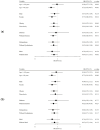Higher Adherence to the Mediterranean Diet Is Associated with a Lower Risk of Steatotic, Alcohol-Related, and Metabolic Dysfunction-Associated Steatotic Liver Disease: A Retrospective Analysis
- PMID: 39458545
- PMCID: PMC11510508
- DOI: 10.3390/nu16203551
Higher Adherence to the Mediterranean Diet Is Associated with a Lower Risk of Steatotic, Alcohol-Related, and Metabolic Dysfunction-Associated Steatotic Liver Disease: A Retrospective Analysis
Abstract
Background and aims: Metabolic liver disease is associated with obesity, insulin resistance, cardiovascular disease, and metabolic disorders. A Mediterranean diet (MD), known for its anti-inflammatory and antioxidant properties, is effective in managing various chronic diseases, including liver diseases. This study aimed to explore the influence of adherence to the MD on the risk of chronic metabolic diseases, including steatotic liver disease (SLD), metabolic dysfunction-associated steatotic liver disease (MASLD), and alcohol-related liver diseases (ALDs).
Methods: This retrospective cohort study analyzed 5395 individuals from a single center between 2020 and 2022, grouped by adherence to the MD using the Korean Mediterranean Diet Adherence Score (K-MEDAS). MASLD score, ALD, and cardiovascular risk factors were also assessed. Statistical analyses were performed using 1:1 exact matching and multiple regression to compare the less adherent (K-MEDAS 0-7) and highly adherent (K-MEDAS 8-13) groups.
Results: Adjusting for confounding variables, high adherence to the MD was significantly associated with lower rates of SLD (odds ratio [OR] 0.818, 95% confidence interval [CI] 0.700-0.957, p = 0.012), MASLD (OR 0.839, 95% CI 0.714-0.986, p = 0.033), and ALD (OR 0.677, 95% CI 0.671-0.683, p < 0.001). Post-propensity score matching analysis revealed that the highly adherent group exhibited significantly lower triglyceride levels, triglyceride and glucose index, atherogenic Index of Plasma, and Framingham risk scores than the less adherent group.
Conclusions: Good adherence to the MD considerably reduces the risk of SLD, MASLD, and ALD, underscoring its protective effects and potential to prevent metabolic liver diseases and their complications.
Keywords: Mediterranean diet adherence; alcohol-related liver disease; metabolic dysfunction-associated steatotic liver disease; steatotic liver disease.
Conflict of interest statement
The authors declare no conflict of interest.
Figures



Similar articles
-
Interplay of Mediterranean-diet adherence, genetic factors, and metabolic dysfunction-associated steatotic liver disease risk in Korea.J Transl Med. 2024 Jun 25;22(1):591. doi: 10.1186/s12967-024-05408-z. J Transl Med. 2024. PMID: 38918799 Free PMC article.
-
Metabolic Dysfunction-Associated Steatotic Liver Disease and All-Cause and Cause-Specific Mortality.Diabetes Metab J. 2025 Jan;49(1):80-91. doi: 10.4093/dmj.2024.0042. Epub 2024 Aug 28. Diabetes Metab J. 2025. PMID: 39197834 Free PMC article.
-
High-Sensitivity C-Reactive Protein Levels in Metabolic Dysfunction-Associated Steatotic Liver Disease (MASLD), Metabolic Alcohol-Associated Liver Disease (MetALD), and Alcoholic Liver Disease (ALD) with Metabolic Dysfunction.Biomolecules. 2024 Nov 18;14(11):1468. doi: 10.3390/biom14111468. Biomolecules. 2024. PMID: 39595644 Free PMC article.
-
Mediterranean diet for the management of metabolic dysfunction-associated steatotic liver disease in non-Mediterranean, Western countries: What's known and what's needed?Nutr Bull. 2024 Dec;49(4):444-462. doi: 10.1111/nbu.12707. Epub 2024 Sep 11. Nutr Bull. 2024. PMID: 39258424 Review.
-
Steatotic Liver Disease: Metabolic Dysfunction, Alcohol, or Both?Biomedicines. 2023 Jul 26;11(8):2108. doi: 10.3390/biomedicines11082108. Biomedicines. 2023. PMID: 37626604 Free PMC article. Review.
Cited by
-
Milpa Diet for MASLD in Mesoamerican Populations: Feasibility, Advantages, and Future Perspectives.Life (Basel). 2025 May 19;15(5):812. doi: 10.3390/life15050812. Life (Basel). 2025. PMID: 40430238 Free PMC article. Review.
-
Adherence to the planetary health diet index and metabolic dysfunction-associated steatotic liver disease: a cross-sectional study.Front Nutr. 2025 Feb 20;12:1534604. doi: 10.3389/fnut.2025.1534604. eCollection 2025. Front Nutr. 2025. PMID: 40051965 Free PMC article.
-
The Influence of Mediterranean and Western Dietary Patterns on Sensory Perception and Taste Sensitivity: A Study Among University Students.Foods. 2025 Aug 15;14(16):2827. doi: 10.3390/foods14162827. Foods. 2025. PMID: 40870739 Free PMC article.
-
Malnutrition in Substance Use Disorders: A Critical Issue in Their Treatment and Recovery.Healthcare (Basel). 2025 Apr 10;13(8):868. doi: 10.3390/healthcare13080868. Healthcare (Basel). 2025. PMID: 40281819 Free PMC article. Review.
-
Dietary Influences on Gut Microbiota and Their Role in Metabolic Dysfunction-Associated Steatotic Liver Disease (MASLD).Nutrients. 2024 Dec 31;17(1):143. doi: 10.3390/nu17010143. Nutrients. 2024. PMID: 39796579 Free PMC article. Review.
References
-
- Israelsen M., Torp N., Johansen S., Hansen C.D., Hansen E.D., Thorhauge K., Hansen J.K., Villesen I., Bech K., Wernberg C., et al. Validation of the new nomenclature of steatotic liver disease in patients with a history of excessive alcohol intake: An analysis of data from a prospective cohort study. Lancet Gastroenterol. Hepatol. 2024;9:218–228. doi: 10.1016/S2468-1253(23)00443-0. - DOI - PubMed
-
- Zheng J., Zhao L., Dong J., Chen H., Li D., Zhang X., Hassan M.M., Steck S.E., Li X., Xiang Y.B., et al. The role of dietary factors in nonalcoholic fatty liver disease to hepatocellular carcinoma progression: A systematic review. Clin. Nutr. 2022;41:2295–2307. doi: 10.1016/j.clnu.2022.08.018. - DOI - PubMed
MeSH terms
Grants and funding
LinkOut - more resources
Full Text Sources

